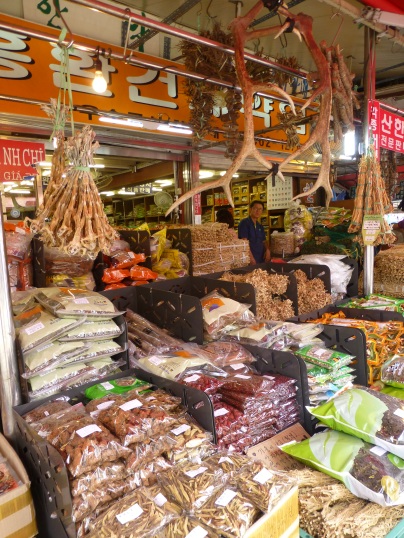
Seoul’s Medicine Market
I’ve always been fascinated with oriental medicine. Using herbal medicines and natural healing to stay healthy just seems like the right way to live. Growing up in a Western culture, where I am thankful to have highly developed scientific advancement of modern medicine, unfortunately I did not have a lot of exposure to natural curses and practices of oriental medicine.
When I arrived in Seoul I was excited to explore oriental medicine and see it being practiced first hand. One of the most exciting markets I have visited is Seoul’s Medicine Market. Korean is a country who’s culture is so enrooted in traditional medicine practice, that many of their everyday meals combine herbal medicine to incorporate health into everyday life.
Located outside Jegi Station in Dongdaemun, is the Yangnyeongsi Herb Medicine Market. You won’t have a doubt you are in the proper location, as you leave exit 1 and the smell of herbs intoxicates you. Vendors range from wholesale shops and pharmacies to street vendors and elders that sit on the ground peddling their goods.

A great way to get oriented with Oriental Medicine is to pay a visit to Seoul’s Yangnyeongsi Herb Medicine Museum first. This state of the art museum is free to visitors. The museum aims to pass on the history and culture of Korean oriental medicine. I was amazed as I walked down the many stairs, into the basement museum and a LED screen illuminated before my eyes giving me an introduction to Korean medicine. Once complete the screen split and a door opened into the museum. Talk about a display of Korea’s modern technology!
The museum features several sections including the “The History and Culture of Korean Oriental Medicine”, “Korean Oriental Medicine and the Human Body”, “Medicinal Herb Village Story”, “A Prescription for Harmony”, “Korean Oriental Medicine Experience Corner for Children” and “The History and Traditions of Seoul Yangnyeongsi”. Several hundred kinds of Korean Medicine are on display at the museum with explanations and descriptions.
The museum features a culture center offering samples of medicinal tea and other interactive activities. When I visited the center they taught me how to grind and pack herbs in a traditional package. I also had a screening to determine my body type and then was given tips on how to improve my lifestyle by an on site doctor.
Once back outside the museum, I walked into the market. The main street is decorated in a stunning archway with sculptors of traditional tools on each side. Roaming the streets I immediately was able to recognize some of the medicines I had seen in the museum. Dry frogs and antlers hang from stalls. Heaps of roots and leaves lie in piles. “Wow they really do use this stuff,” was the first thought that came to mind. It was exciting to actually be able to identify why it was being used. It is one thing to learn about medicine in a museum or book, but seeing it in everyday life is fascinating.
Herb clinics, where oriental medicine doctors give treatments, are scattered throughout the market. If you are looking for a specific treatment, visiting these doctors will surely be beneficial. Westerns often visit clinics to receive help natural healing with back pain, weight loss and immune system boosting. Many of these clinics also offer traditional treatments like acupuncture and cupping.
The traditional pharmacies, with large floor to ceiling wooden file cabinets, filled with oriental medicine, is a must see site. Old women sit in waiting rooms chatting and drinking medicinal tea as they wait for the pharmacist to open the large wood cabinets, engraved with Korean writing identifying the scientific name of the medicinal herb.
If you are looking to buy some of Korea’s world famous red ginseng entire buildings, located in this district, are filled, from basement to rooftop, with vendors offering various forms of ginseng at wholesale pricing. Ginseng has been found to aid in type 2 diabetes, physical and mental health stimulation, weight control, menstrual problems and immune system boosting as well as a variety of other benefits. Korea is the largest producer of ginseng. World sales of the product were over 2.1billion dollars in 2010, with over half coming from South Korea. In effort to build my immune system for the upcoming winter months, I picked up a bottle of red ginseng pills. I’m hoping for a healthy winter with the aid of this supplement!
During your time in Korea, I highly recommend a visit to Seoul’s medicine market! If you’d like to visit the market with a guide the Seoul Metropolitan Government offers a walking tour free of charge.
Subway: Jegi Station (Seoul Subway Line 1), Exit 2
If you love markets make sure to tune inevery first Monday of the month where I highlight a different market in Seoul!
Want to explore another great market while you’re in the area? Cheongnyangni Fruit and Vegetable Market is right next door!









